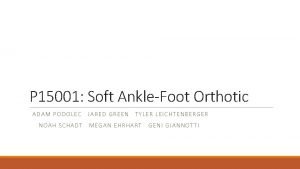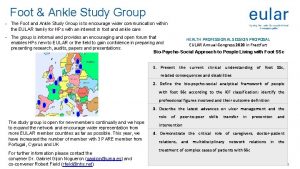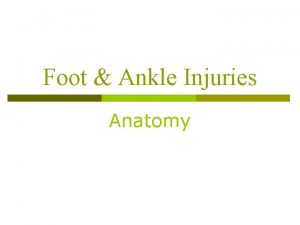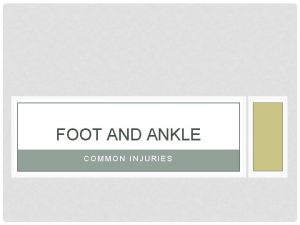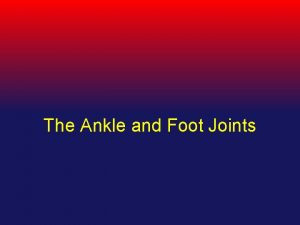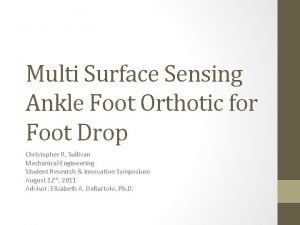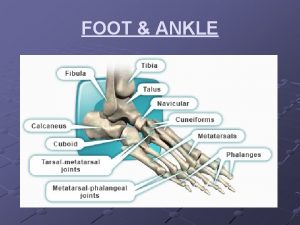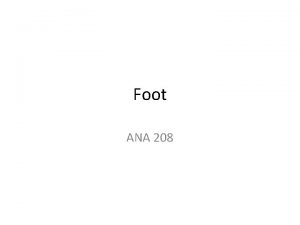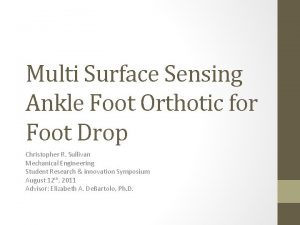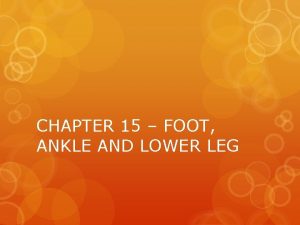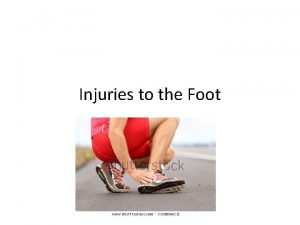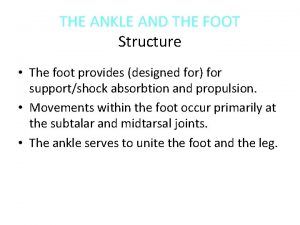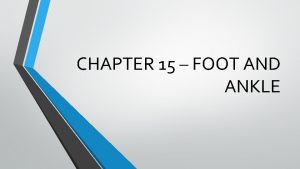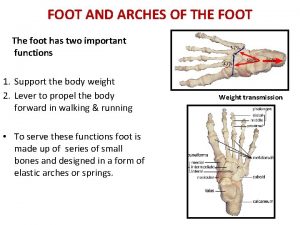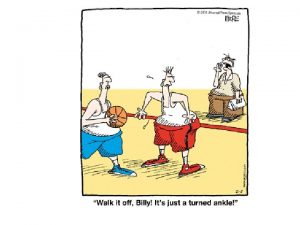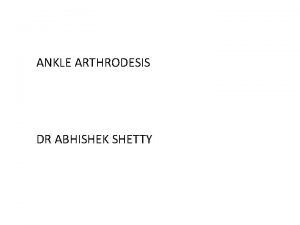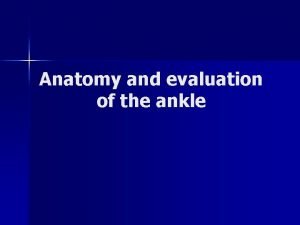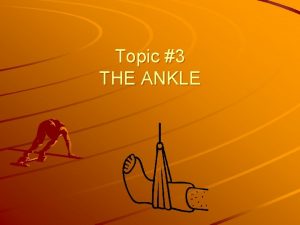The Foot Ankle Foot Ankle There are 28










































- Slides: 42

The Foot & Ankle

Foot & Ankle There are 28 bones in the lower leg/foot including: Tibia & Fibula: Malleolus – (medial & lateral) ends of the tibia & fibula (commonly referred to as the ankle bones) Talus: sits on top of the calcaneus (forms the ankle joint along with tibia & fibula) Calcaneus: heel bone (Achilles Tendon attaches posteriorly to it) 5 Tarsals: Navicular, Cuboid, and 3 Cuneiforms 5 Metatarsals: #1 -#5; #1 is the big toe 14 Phalanges 2 Sesamoid (small bones under 1 st metatarsal)



Foot & Ankle injuries are among the most common injuries (most frequently injured joint) Lower leg roles: Balance Shock absorption movements Foot/Ankle Movements: Plantar and dorsiflexion Inversion and eversion Pronation and supination

Arches of the Foot The foot has 3 arches Metatarsal Arch: across the heads of metatarsals Transverse Arch: in front of the heel from the 5 th metatarsal to navicular bone Longitudinal Arch: runs the length of the foot from the calcaneus to metatarsal heads

Arches of the Foot

Pes Planus = flat feet Shallow or flat longitudinal arch

Foot & Ankle Muscles Peronues Brevis & Longus Provide stability to the lateral aspect of ankle Gastrocnemius Provides plantar flexion allowing for running and jumping Attaches by the Achilles Tendon onto the posterior of the calcaneus Soleus Muscle underneath the gastrocnemius that assists in plantar flexion Tibialis Anterior Provides dorsiflexion of the ankle

Muscles

Ligaments of the Foot/Ankle Lateral Ligaments Anterior Talofibular Posterior Talofibular Calcaneofibular

Lateral Ligaments

Medial Ligaments Medial Ligaments: Deltoid Tibiocalcaneal Anterior/Posterior Tibitalar Tibionavicular

Medial Ligaments The deltoid ligament is stronger than all lateral ligaments combined

Foot/Ankle Injuries

Preventing Injuries Good shoes Ankle Tape Shin Guards Proper Strength/Conditioning Programs

Great Toe Sprain Aka: Turf Toe Functions of Great Toe: Kick a ball, push off when running, balance Cause: excessive forced flexion/extension Symptoms: pain, swelling, discolored, inability to walk or run normally Treatment: rice, tape/padding More common on turf than grass

Arch Sprain of the transverse and longitudinal arch Caused by: running on hard surfaces, improper footwear, overuse Symptoms: pain, difficulty walking/running, discoloration over plantar surface Treatment: PRICE, padding, strengthen muscles, & stretch Achilles Tendon

Ankle Sprains Inversion and Eversion Sprains Inversion Sprains are much more common (85% of all sprains): Deltoid ligament (medial) is much stronger than lateral ligaments Lateral malleolus prevents eversion from occurring

Severity of Ankle Sprain The severity of the sprain will depend on: Amount of force Amount of protective taping Type of shoe Strength of muscles

Ankle Sprain Evaluation Symptoms: Swelling Discoloration Loss of ROM

Treatment If there is no decrease in ROM or strength – athlete can be taped and return to play If there is a decrease in ROM: PRICE If there is crepitus, rapid swelling, deformity: refer to doctor This could be a sign of a possible fx

Ankle Dislocation The talus dislocates from tibia & fibula Anterior Dislocation The heel of foot strikes ground forcefully Posterior Dislocation A blow to anterior aspect of leg while ankle is plantar flexed

Ankle Dislocation Symptoms: Pain/refusal to move Not allow touching of foot Deformity & inability to use foot Rapid swelling Treatment: 911 Ligaments, Nerves, Blood Vessels all injured

Tendinitis Occurs from repetitive running, jumping, and landing Achilles Tendon is susceptible Symptoms Swelling, tenderness, crepitus, pain upon palpation (dorsiflexion) Treatment Rest, ice, refer to doctor & gentle stretching

Achilles Tendon may get thicker as the body responds to injury Limits ROM and decreased ability in running/jumping Severe Damage: feel crepitus or tendon may completely rupture

Achilles Tendon Rupture Athlete falls and feels like they have been shot in back of leg Caused by: Forced dorsiflexion Blow over Achilles tendon Sudden contraction of gastrocnemius

Achilles Tendon Rupture Symptoms Weakness, loss of plantar flexion, depression at attachment site Treatment Must be surgically reattached to calcaneus

Common Foot/Ankle Fractures Jones Fracture Avulsion Fracture Epiphyseal Fracture Stress Fracture

Jones Fracture Most common avulsion fracture 5 th metatarsal is fractures as a result of forced inversion Peroneus brevis tendon pulls part of bone away

Distal Tibia & Fibula Avulsion Fracture Medial & Lateral Malleolus is fractured Caused by forced plantar flexion & inversion or eversion

Epiphyseal Fracture Occurs to the tibia and fibula Caused by forced plantar flexion & inversion

Stress Fracture Occurs to the tibia, fibula, and metatarsals Caused by repetitive stress due to running Not visible in x-ray

Shin Splints Aka: Medial Tibial Stress Syndrome Muscle fibers on medial side of tibia becomes torn and irritated

Shin Splints Caused by: Tight calf muscle, improper footwear, improper conditioning/out of shape for running Symptoms Pain/inability to walk/run, pain over distal medial tibia, swelling on lateral side

Shin Splints Treatment: PRICE

Anterior Compartment Syndrome Lower leg is broken down into 4 compartments Anterior Compartment Syndrome can sometimes be mistaken for shin splints

Anterior Compartment Syndrome Muscles in the anterior aspect of the lower leg are enclosed in connective tissue Swelling can cause severe pain & pressure Cause: overuse or impact Symptoms: Hot, red skin Loss of foot motion Severe pain

Anterior Compartment Syndrome Treatment: Doctor May need surgery Incision in leg to relieve pressure

Hammer Toe PIP joint of toe is flexed while MTP & DIP joints are hyperextended

Plantar Faciitis Irritation of fascia on the bottom of the foot – commonly at the attachment on the calcaneus Causes: excessive running or standing on hard surfaces; sudden increase in activity; improper footwear; and tight Achilles Tendon

Plantar Faciitis Symptoms: pain upon initial weight bearing, especially in the morning
 Insidan region jh
Insidan region jh Physiology of the foot and ankle
Physiology of the foot and ankle Ankle foot orthoses
Ankle foot orthoses Foot orthosis design challenge
Foot orthosis design challenge Put your right foot in
Put your right foot in Horizontal
Horizontal There is an empty basket that is one foot in diameter
There is an empty basket that is one foot in diameter Tỉ lệ cơ thể trẻ em
Tỉ lệ cơ thể trẻ em Fecboak
Fecboak đặc điểm cơ thể của người tối cổ
đặc điểm cơ thể của người tối cổ Các châu lục và đại dương trên thế giới
Các châu lục và đại dương trên thế giới Thế nào là hệ số cao nhất
Thế nào là hệ số cao nhất Hệ hô hấp
Hệ hô hấp ưu thế lai là gì
ưu thế lai là gì Môn thể thao bắt đầu bằng chữ f
Môn thể thao bắt đầu bằng chữ f Tư thế ngồi viết
Tư thế ngồi viết Cái miệng nó xinh thế
Cái miệng nó xinh thế Hình ảnh bộ gõ cơ thể búng tay
Hình ảnh bộ gõ cơ thể búng tay Cách giải mật thư tọa độ
Cách giải mật thư tọa độ Tư thế ngồi viết
Tư thế ngồi viết Gấu đi như thế nào
Gấu đi như thế nào Thẻ vin
Thẻ vin Thể thơ truyền thống
Thể thơ truyền thống Các châu lục và đại dương trên thế giới
Các châu lục và đại dương trên thế giới Từ ngữ thể hiện lòng nhân hậu
Từ ngữ thể hiện lòng nhân hậu Khi nào hổ mẹ dạy hổ con săn mồi
Khi nào hổ mẹ dạy hổ con săn mồi Diễn thế sinh thái là
Diễn thế sinh thái là Vẽ hình chiếu vuông góc của vật thể sau
Vẽ hình chiếu vuông góc của vật thể sau Slidetodoc
Slidetodoc Giọng cùng tên là
Giọng cùng tên là 101012 bằng
101012 bằng Lời thề hippocrates
Lời thề hippocrates Tư thế worm breton
Tư thế worm breton đại từ thay thế
đại từ thay thế Quá trình desamine hóa có thể tạo ra
Quá trình desamine hóa có thể tạo ra Công thức tính độ biến thiên đông lượng
Công thức tính độ biến thiên đông lượng Thế nào là mạng điện lắp đặt kiểu nổi
Thế nào là mạng điện lắp đặt kiểu nổi Các loại đột biến cấu trúc nhiễm sắc thể
Các loại đột biến cấu trúc nhiễm sắc thể Vẽ hình chiếu đứng bằng cạnh của vật thể
Vẽ hình chiếu đứng bằng cạnh của vật thể Biện pháp chống mỏi cơ
Biện pháp chống mỏi cơ Bổ thể
Bổ thể Phản ứng thế ankan
Phản ứng thế ankan Sự nuôi và dạy con của hươu
Sự nuôi và dạy con của hươu


